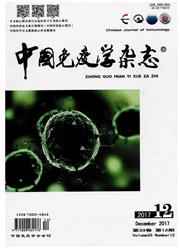

 中文摘要:
中文摘要:
目的:探讨获取较高纯度和活性人表皮朗格汉斯细胞(Langerhans cell, LC)的实验方法,并观察分选所获人表皮LC接受免疫调节剂咪喹莫特刺激后细胞因子mRNA表达的变化.方法:联合采用密度梯度离心和免疫磁珠的方法分离纯化人表皮LC,将分选后的细胞用结合有FITC的鼠抗人CD1a单抗标记,经流式细胞仪检测LC纯化率,采用0.4%台盼蓝染色检测细胞的活性.将人表皮LC分为实验组和对照组,实验组加5 μg/ml咪喹莫特,对照组不加药,处理4小时后提取总RNA,采用RT-PCR法检测各组细胞中细胞因子TNF-α、IL-1β及IL-6 mRNA的表达量.结果:流式细胞仪检测分选后LC纯化率为84.48%,台盼蓝染色显示细胞活性>95%.LC经咪喹莫特处理后的实验组TNF-α、IL-1β及IL-6三种细胞因子mRNA表达量均较对照组显著增高(P<0.05).结论:联合应用密度梯度离心和免疫磁珠法,可获得较高纯度、有活性的LC细胞,且具有操作简单、易于无菌条件下分离纯化的优点.LC能接受咪喹莫特刺激而上调细胞因子mRNA的表达.
 英文摘要:
英文摘要:
Objective:To detect a better method to obtain purified and viable Langerhans cells from human epidermis and observe the effect of imiquimod on the mRNA expressions of eytokines from human epidermal Langerhans cells. Methods: Density gradient eentrifugation and magnetic cell sorting were used simultaneously to separate and purify the Langerhans cells from human epidermis. The separated cells were specially marked by monoelonal mouse-anti-human CD1a antibody conjugated to FITC. The purification rate was analyzed by flow cytometric fluorography analysis and the cell viability was observed by 0. 4% trypan blue staining. Langerhans cells were divided into two groups——experimental group and control group. The solution of 5 μg/ml imiquimod was added to the experimental group and the culture medium for the control group. The total RNA was harvested 4 h after application. RT-PCR was conducted to detect the mRNA expressions of TNF-α, IL-1β and IL-6 in each group. Results:The purification rate of Langerhans cells was 84. 48% and the viability of Langerhans cells was more than 95%. Expression levels of TNF-α, IL-1β and IL-6 mRNA of Langerhans cells 4 h after 5 μg/ml imiquimod application were statistically higher than the controls ( P 〈 0. 05 ). Conclusion : Combining the techiques of density gradient centrifugation and magnetic cell sorting is highly effective to obtain the better purificated and more active Langerhans cells from human skin. And this method is easy to manipulate under sterile conditions. The imiquimod could increase the mRNA expression of TNF-α, IL-1β and IL-6 from sorted Langhans cells.
 同期刊论文项目
同期刊论文项目
 同项目期刊论文
同项目期刊论文
 期刊信息
期刊信息
